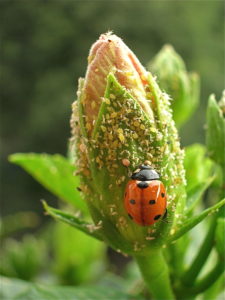Our last blog looked at three common insects that can infest the tropical plants in your home and office. This week we will look at the remaining common insects: thrips, fungus gnats, aphids and whitefly.
Thrips are the common name given to a genus of insect with over 6000 species. Only a few are an issue with indoor tropical plants. This is the most serious insect that can affect plants, as it can spread rapidly and does significant damage. It is also very difficult to treat, as the young larvae and nymphs hide in the new leaves that are not yet open, making any kind of spraying largely ineffective. This insect is dreaded by interiorscapers. We cannot use pesticides indoors, so are very limited in how to control an infestation. Most thrips are introduced into a commercial office plantscape from low quality or weak plants brought in by staff from home or purchased from big box stores that do not properly handle the plants prior to sale. Outdoor plants brought inside for the winter are also a common source of thrips as well as many other insects.
Thrips are very tiny, (1mm) elongated insects with wings. It is not easy to see them on the plant; most often we see the excrement on the undersides of the leaves. This appears as very small black dots that can be flicked off. Once the insect has established itself on the plant, the damage quickly becomes apparent. As the insects suck the leaves, they inject digestive enzymes, leaving a very distinctive silver or bronze area in the leaf.
Insecticidal soaps and simple soap and water solutions may be slightly effective in reducing an infestation, but these must be applied frequently as the insect multiplies so quickly. Certain foliage cleaners that leave a protective film on the leaves may also help, but again, are considered a way to slow down the spread only. Prevention is key. We strongly encourage our commercial clients to limit or prohibit staff from bringing in personal plants. Insect infestations introduced by personal plants usually invalidate any warranty on the contract plants.
Fungus gnats are another common insect associated with indoor plants. These fruitfly-like pests are more of an annoyance than anything. They fly around light sources like computer screens. Fungus gnats live in the soil, not on the plant. They like wet soil, so are always associated with plants that have be consistently over-watered. They fly out of the soil when the plant is watered, and often spread to nearby wet plants. Again, prevention is easier than treatment. Keep plants as dry as they will tolerate, and purchase only from a reputable greenhouse. Fungus gnats are very common in plants from grocery and big box stores. Treatment is straightforward, but can take time. In involves drying out the plants, and adding a lime substrate to change the pH of the soil. Sharp sand (diatomaceous earth) can also be effective. This kills the larvae as they climb through the soil. It does not do anything to the adult insects though. Getting rid of these can only be accomplished by drying out the soil. In severe cases, changing the soil may be necessary. The correct soil is critical. Heavy outdoor type soils will hold too much water. Tropical plants need a very light porous soil that drains well.
Aphids and whitefly are rarely a problem in a professionally maintained plantscape. These insects tend to be found on plants that have been outdoors such as hibiscus. People often want to keep these flowering tropicals over the winter. In nearly 100% of cases, plants that have been outdoors for the summer will have some sort of pest. Aphids may spread to a few types of indoor tropical plants such as schefflera. Whitefly are usually only found on hibiscus. If you plan to bring a plant indoors, check carefully for insects. Spraying with a commercial insecticidal soap or a home made treatment may temporarily reduce the number of bugs but will not eradicate them. It is often better to discard outdoor plants at the end of the summer season, and purchase new ones in the spring.

Thrips insect

Thrips

Aphid insects on hibiscus bud
Share
OCT
2016
